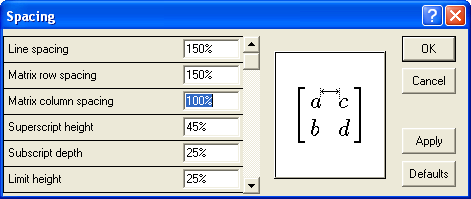Written by Allen Wyatt (last updated December 21, 2024)
This tip applies to Word 97, 2000, 2002, and 2003
When using the Equation Editor, you can control the spacing used by the Equation Editor between matrix columns in an equation. The value you specify represents a percentage of the normal spacing that would otherwise be used. Thus, a value of 150% represents a spacing that is half again as large as normal. The default setting is 100%, meaning the spacing is the same as normal. You can change the spacing, however, by following these steps:

Figure 1. The Spacing dialog box.
WordTips is your source for cost-effective Microsoft Word training. (Microsoft Word is the most popular word processing software in the world.) This tip (933) applies to Microsoft Word 97, 2000, 2002, and 2003.

Create Custom Apps with VBA! Discover how to extend the capabilities of Office 365 applications with VBA programming. Written in clear terms and understandable language, the book includes systematic tutorials and contains both intermediate and advanced content for experienced VB developers. Designed to be comprehensive, the book addresses not just one Office application, but the entire Office suite. Check out Mastering VBA for Microsoft Office 365 today!
You can adjust the distance between the equation body and a limit line.
Discover MoreIf you use the Equation Editor a lot in creating your documents, you'll benefit by making sure it is accessible as ...
Discover MoreYou can adjust where an equation is printed by moving it minute amounts in any direction.
Discover MoreFREE SERVICE: Get tips like this every week in WordTips, a free productivity newsletter. Enter your address and click "Subscribe."
There are currently no comments for this tip. (Be the first to leave your comment—just use the simple form above!)
Got a version of Word that uses the menu interface (Word 97, Word 2000, Word 2002, or Word 2003)? This site is for you! If you use a later version of Word, visit our WordTips site focusing on the ribbon interface.
Visit the WordTips channel on YouTube
FREE SERVICE: Get tips like this every week in WordTips, a free productivity newsletter. Enter your address and click "Subscribe."
Copyright © 2026 Sharon Parq Associates, Inc.
Comments